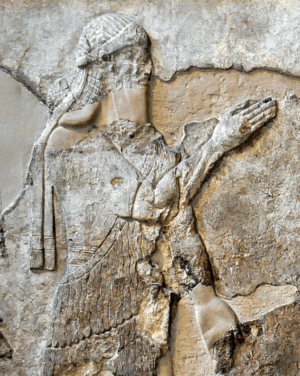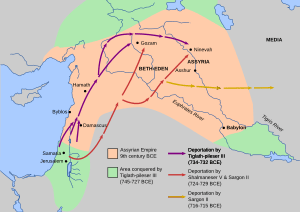Shalmaneser V facts for kids
Quick facts for kids Shalmaneser V |
|
|---|---|
|
|

Possible depiction of Shalmaneser V during his time as crown prince, from one of the reliefs of his father Tiglath-Pileser III
|
|
| King of the Neo-Assyrian Empire | |
| Reign | 727–722 BC |
| Predecessor | Tiglath-Pileser III |
| Successor | Sargon II |
| Died | 722 BC |
| Spouse | Banitu |
| Issue | Ashur-dain-aplu (?) Other children (?) |
| Akkadian | Salmānu-ašarēd |
| Dynasty | Adaside dynasty |
| Father | Tiglath-Pileser III |
| Mother | Iaba (?) |
Shalmaneser V (Salmānu-ašarēd, meaning "Salmānu is foremost") was a powerful king of the Neo-Assyrian Empire. He ruled from 727 BC until his death in 722 BC. His father was King Tiglath-Pileser III.
Shalmaneser V's time as king was short, and we don't have many records from his reign. However, he is famous for conquering the city of Samaria. This led to the fall of the Kingdom of Israel. Some people think his successor, Sargon II, finished this campaign.
Shalmaneser V fought many wars in lands west of Assyria. He battled the Israelites, the Phoenician city-states, and kingdoms in Anatolia. He added some lands to the Assyrian Empire. But his wars often involved long sieges that lasted for years. The way he died is not fully clear, but it was likely violent. It's also thought that Sargon II was not his rightful heir. Shalmaneser V might have been the last king of the Adaside dynasty, which had ruled Assyria for almost a thousand years.
Shalmaneser V was also known by the name Ululayu. This name means "one who was born in the month Ulūlu". Some old records use this name instead of Shalmaneser. But official documents from his time always called him Shalmaneser. This means Ululayu was probably his birth name, not an official king's name.
Contents
About King Shalmaneser V
His Name and What It Means
The name Shalmaneser was only used by Assyrian kings. It was a special name they took when they became king. The name Salmānu-ašarēd means "Salmānu is foremost." Salmānu was a god popular in ancient Assyria.
Kings like Shalmaneser V probably chose this name to connect themselves to famous past kings. These included Shalmaneser I and Shalmaneser III, who were known for their conquests.
The modern name 'Shalmaneser' comes from how it's written in the Bible. In Hebrew, it has a different meaning, like "peace in chains" or "covenant of reward."
Shalmaneser V was also called Ululayu. This name means "born in the month of Ulūlu." Later historians used this name. But letters from his time as a prince show he used Ululayu then. Official documents, however, only used Shalmaneser. This suggests Ululayu was his birth name.
Shalmaneser as a Prince
Shalmaneser V was the son of King Tiglath-Pileser III. While he was a prince, he sent letters to his father. In these letters, he used the name Ululayu. The letters usually started by saying that everything was well in his lands.
As a prince, Shalmaneser handled diplomatic tasks. He also managed things related to the royal palace. He controlled some areas for his father, possibly near the center of Assyria. Historians think he might have been a regent, ruling in his father's place when the king was away fighting wars. He likely also joined his father in military campaigns.
Shalmaneser V's Reign
How We Know About Him

Shalmaneser V became king of both Assyria and Babylonia after his father died. There were no major challenges to his rule at first. But very few records from his short reign have survived. This makes it hard to know exactly what he did as king.
We have some inscriptions on lion-shaped weights that mention him. These weights might show that he tried to create a standard system of weights for the whole country. He also seems to have done some building work in the city of Apqu. But he probably spent most of his time fighting wars.
Old records from Babylonia say he became king in December or January. He died in his fifth year as king. His successor, Sargon II, took the throne shortly after. Shalmaneser V was part of the "Assyrian dynasty."
Assyrian kings usually took on a special role called "eponym" in their second year. This meant the year was named after them. Shalmaneser V broke this tradition and became eponym in his fourth year. Kings after him also changed this custom. This suggests Shalmaneser V made some new rules for how the kingdom was run.
Rule in Babylonia
Shalmaneser V was mostly accepted as king in Babylonia. But he did face some challenges from tribes in the south. An old letter mentions that he deported people from a place called Bit-Dakkuri. This was a common Assyrian practice to control conquered groups.
One old inscription, though damaged, seems to belong to Shalmaneser V. It talks about rebuilding work in the city of Borsippa. It also mentions a campaign against rebels in the south. This shows he was active in keeping control over Babylonia.
Conquering Samaria and Western Wars
The city of Samaria was the capital of the Kingdom of Israel. Assyrians besieged and captured it in the 720s BC. This conquest ended the Kingdom of Israel. About thirty thousand Israelites were moved to other parts of the Assyrian Empire. This was a common Assyrian way to deal with defeated enemies. This event led to the famous story of the Ten Lost Tribes of Israel.
There is some debate about whether Shalmaneser V or Sargon II captured Samaria. Both Babylonian records and the Bible say Shalmaneser V did it. The Bible even says the siege lasted three years. But Sargon II also claimed he conquered it.

Some historians think Shalmaneser V started the long siege, and Sargon II finished it after Shalmaneser's death. Others believe Shalmaneser V captured the city in 722 BC, and Sargon II later put down another revolt there. Either way, the capture of Samaria was seen as a very important event during Shalmaneser V's reign.
Shalmaneser V also fought other wars in the west. He campaigned against the coastal cities of Phoenicia. One historian mentions a five-year siege of Tyre during his reign. This siege might not have been finished when Shalmaneser V died. He also fought against the kingdom of Tabal in Anatolia. It's likely he added new lands between Tabal and Assyria to his empire.
His Overthrow and Death
Shalmaneser V was removed from power in 722 BC. Sargon II became the new king. The exact details of how this happened are not clear, but it was likely violent. Sargon II's own records don't say much about Shalmaneser's end. One inscription from Sargon calls Shalmaneser a "godless tyrant" who took away rights from important cities. However, other records by Sargon suggest these problems started before Shalmaneser's reign.
It's believed Shalmaneser V was killed when he was overthrown. Old records simply say he met "the fate," which means death. Sargon's rise to power was not smooth. Many Assyrians likely supported Shalmaneser V or his rightful heir. Sargon had to deal with many "guilty Assyrians" by moving them to new places. His rule was also challenged in Babylonia by a chief named Marduk-apla-iddina II.
Later Assyrian king lists say Sargon was Tiglath-Pileser's son, making him Shalmaneser's brother. But Sargon's own inscriptions say he was chosen by the god Ashur. Many historians believe Sargon was not the rightful heir after Shalmaneser. If Sargon was not related to Shalmaneser, then Shalmaneser V was the last king of the Adaside dynasty. This dynasty had ruled Assyria for nearly a thousand years.
Family Life
Shalmaneser's Queen
Shalmaneser V's wife and queen was named Banitu. Her tomb was found in excavations at the Northwest Palace in Nimrud. The tomb contained objects belonging to three queens, including Banitu. This discovery helps us learn more about the royal family.
Siblings and Children
If Sargon II was Shalmaneser V's brother, they had at least one other brother named Sin-ahu-usur. Sin-ahu-usur was an important official and helped Sargon in his military campaigns.
Since Sargon II was likely not Shalmaneser V's rightful heir, it suggests Shalmaneser had other children who would have been. Historians think that a palace official named Ashur-dain-aplu might have been one of Shalmaneser V's sons. He is called "son of Shalmaneser" in a letter. If he was Shalmaneser V's son, he managed to survive the difficult change in power and continued his career in the palace.
Royal Titles
Shalmaneser V used many grand titles to show his power. In one inscription, he called himself:
- "The mighty king"
- "King of the Universe"
- "King of Assyria"
- "King of the Four Regions of the World"
- "Viceroy of Babylon"
- "King of Sumer and Akkad"
- "Most precious descendant of Assyria, seed of royalty, of the eternal days."
See also
 In Spanish: Salmanasar V para niños
In Spanish: Salmanasar V para niños



